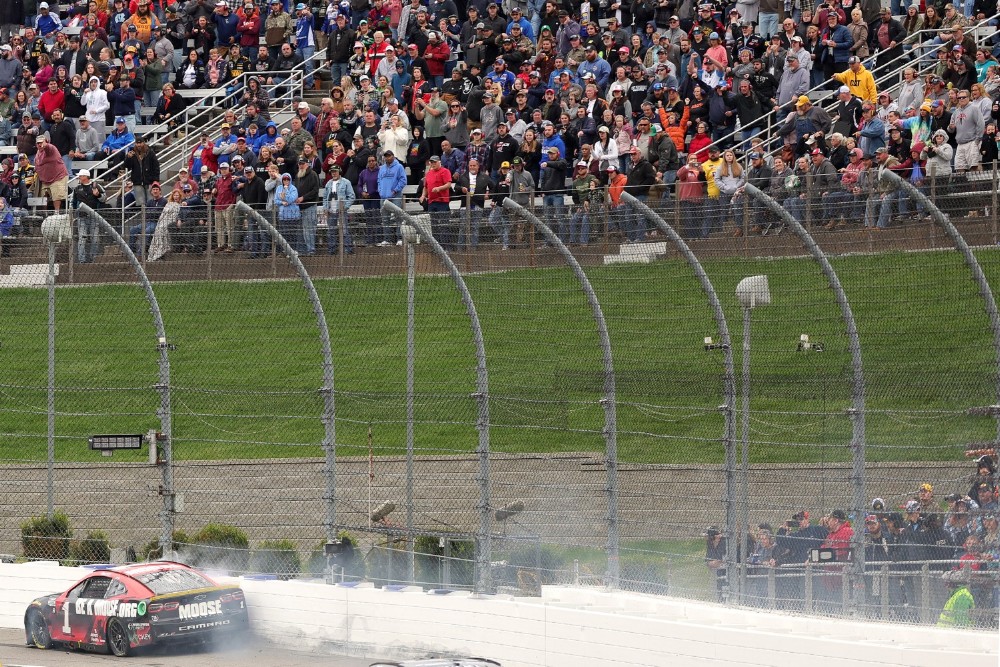NASCAR: Series bans Chastain wall-ride maneuver, outlines rule changes for 2023 season
NASCAR announced Tuesday that stage racing at road courses will have a new look in 2023 with no caution flags interrupting the flow of competition. Additionally, the sanctioning body will enforce rules already written in the NASCAR Rule Book to officiate vehicles that employ a similar strategy to the one Ross Chastain used in his “Hail Melon” move at Martinsville Speedway by issuing a time penalty.
The removal of stage cautions at road courses comes following a review of Fan Council Data and industry discussions. Stage points will still be awarded at the stage-ending lap, but the green-checkered flag will not be displayed and there will not be a caution period to interrupt the action.
The move comes in hopes of encouraging and improving pit strategies employed by race teams throughout the course of a road race. This change will be implemented at all NASCAR Cup Series road courses. However, standalone road-course races in the NASCAR Xfinity Series and NASCAR Craftsman Truck Series races (Portland, Mid-Ohio, Road America) will continue to see caution periods separate stages.
NASCAR returns to Circuit of The Americas on March 26, marking the first road course of the season that won’t feature stage cautions.
Chastain’s dash around Turns 3 and 4 at Martinsville Speedway last October made for a thrilling finish as the No. 1 Chevrolet gained five positions in one set of turns, earning enough points to advance to the Championship 4.
While the move was thrilling and largely lauded for its creativity, it also came with an increased safety risk. Therefore, NASCAR will not add new language to the rule book but instead point to rule 10.5.2.6.A, which states: “Safety is a top priority for NASCAR and NEM (NASCAR Event Management). Therefore, any violations deemed to compromise the safety of an Event or otherwise pose a dangerous risk to the safety of Competitors, Officials, spectators, or others are treated with the highest degree of seriousness. Safety violations will be handled on a case-by-case basis.”
Officials stated they will issue a time penalty to any vehicle that attempts an unsafe maneuver like Chastain’s.
In the days following his move, Chastain emphasized he was not eager to make that decision again any time soon.
“Why it worked? I don’t know, but I have no ideas or plans to ever do that again because it was not pleasant,” Chastain said on Championship 4 Media Day.
Other drivers like two-time champion Joey Logano and 2020 title winner Chase Elliott voiced both praise and apprehension toward wall-riding, equally aware of how exciting it looks and the danger that lurks.
In other competition-related news, competition officials have revised the penalty structure for detached wheels, shifting away from the four-race crew chief suspension that had been in place since 2015.
In the event of a lost wheel that is contained to pit road, the offending team will be subject to a pass-through penalty under green-flag conditions. If the infraction occurs during a caution period, the offending team will restart at the tail end of the field.
If the wheel breaks free outside of pit road, the new rules guidelines mandate a two-lap penalty, plus a two-race suspension for two crew members. Each penalty is series-specific: Violations in one series will not impact those crew members’ eligibility to participate in other series.
Competition officials have also expanded the list of tracks where wet-weather equipment could be used in 2023, adding several tracks of 1 mile or less to the mix of road courses. Those events include races at: the Los Angeles Memorial Coliseum, Martinsville Speedway, New Hampshire Motor Speedway, North Wilkesboro Speedway for All-Star weekend, Phoenix Raceway, Richmond Raceway, The Milwaukee Mile and Lucas Oil Indianapolis Raceway Park.
Officials initially tested a wet-weather package for shorter ovals at Martinsville’s 0.526-mile circuit in the spring of 2021. Rain tires and windshield wipers have been available for use at road courses in recent years during inclement weather for all three national series.
Rules for playoff eligibility have been updated in all three NASCAR national series. The requirement that drivers must be among the top 30 (in the Cup Series) or top 20 (in Xfinity and Craftsman Trucks) to retain postseason eligibility has been removed. Drivers will still need to participate in every event to keep playoff eligibility, unless a waiver has been granted and approved by NASCAR.
Below are additional updates coming for the 2023 season:
- The “choose rule” for determining the restart order has been expanded for the 2023 season, with superspeedway and dirt-track events adopting the procedure.
- The restart zone for the first five events of the season will be increased by 50% in length. Officials indicated they would assess after the Atlanta event whether the larger restart zone would be used in subsequent races.
- NASCAR officials adjusted the damaged vehicle policy (DVP), establishing a seven-minute repair clock for work performed on pit road. As was the case last year, no specialized repair tools are allowed. Toe links are allowed to be replaced on pit road during the allotted time.
- Competition officials also updated its event procedure rules regarding vehicle interference with crews during pit stops. Vehicles encroaching on other pit stalls when coming in for service may result in a penalty. Stalls will be highlighted with new orange markings on pit road to assist officials in making those calls. NASCAR.com
